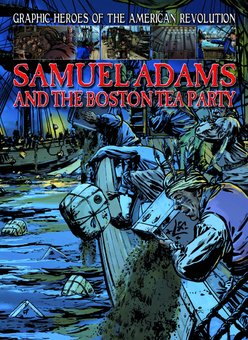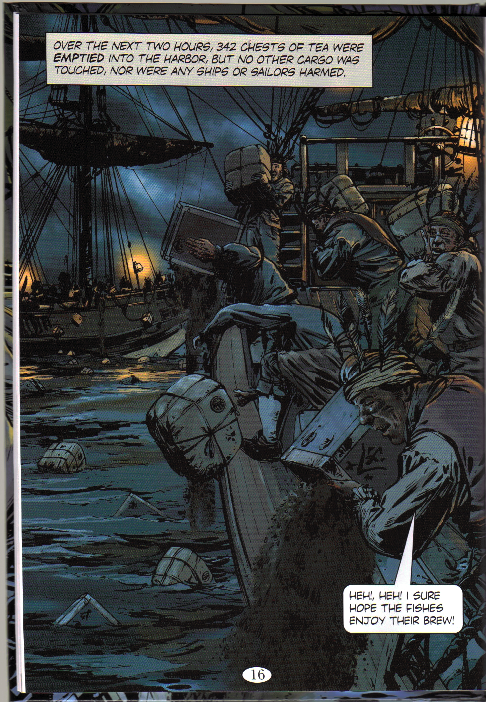
Samuel Adams and the Boston Tea Party by Gary Jeffrey
 This book was rather surprising to me, as I’ve never before seen a graphic novel about the Revolutionary War. This particular one is a part of a series of graphic novels titled “Graphic Heroes of the American Revolutionâ€, each of which is about a particular figure of the American Revolution. The artist, Nick Spender, did a good job portraying the likeness of Samuel Adams in comic (not as in funny) form, especially considering the fact that there is only one full painting of him in existence. All of the artwork in the book is considerably realistic and well done, including a particularly unflattering depiction of King George III.
This book was rather surprising to me, as I’ve never before seen a graphic novel about the Revolutionary War. This particular one is a part of a series of graphic novels titled “Graphic Heroes of the American Revolutionâ€, each of which is about a particular figure of the American Revolution. The artist, Nick Spender, did a good job portraying the likeness of Samuel Adams in comic (not as in funny) form, especially considering the fact that there is only one full painting of him in existence. All of the artwork in the book is considerably realistic and well done, including a particularly unflattering depiction of King George III.
While the book isn’t very long, it is an accurate portrayal of what went down during the winter of 1773. King George III, in an effort to retain control over America via taxes, created a last-ditch tax on British tea. The British forced competitors who smuggled tea out of business, so that Americans were forced buy their tea from Britain. British ships full of tea were set to anchor in Boston’s ports. On November 29th, 1773, the Dartmouth arrived at Boston Harbor but was not allowed to land. All of this history is succinctly summarized in the prologue, accompanied by a few paintings of events and important people involved in the (original) Tea Party.
The story begins in the tea warehouse with Samuel Adams giving a speech on protesting the British tax on tea. This introduces the reader to the the graphic novel format, which is the familiar “speech and thought bubble†layout. While this is generally expected from comic books, it almost felt out of place, a distraction from the seriousness of the topic. The book goes on to show the arrival of two more tea ships, and the captains explaining to their crew that if the ships can’t land by December 17th, they will force the issue and land, with or without the consent of the rebels. The reader learns that Admiral Montague is in control of the ships in the harbor.
The next scene is that of the 16th of December, the day before the ships are set to land. We see an impressive drawing of the crowd gathering in the Old South Meeting House in Boston, where Sam Adams gives his speech to the crowd. The Patriots then dress up as Indians and head to the harbor, quietly and in the night. Harming nothing (except tea) and no one, they expeditiously dump all the tea into the harbor. This scene is a fairly accurate account of what actually happened, contrary to today’s popular conceptions of the Boston Tea Party, portrayed it as a loud and exciting spectacle. The artwork for this portion of the story is particularly pleasing, showing the water realistically as it darkens in areas due to the concentration of the tea.

The next pages show the aftermath of the Americans dumping the tea into the water, the King being enraged at the turn of events, and Samuel Adams recounting the event. Over all, the Samuel Adams And The Boston Tea Party was very enjoyable. The art was very well done, especially the nighttime scene that is used on the cover. The history and depiction of characters and locations is also very accurate. It is worth reading, especially as a vehicle for interesting children in the topic, as it is a medium generally familiar to that audience. I hope to read the others in the series.
 The posts are coming!
The posts are coming!

2 comments
Nice review Mathew – very well written!
[Reply]
Great review Matthew. When I was growing up in the 50’s I used to read ‘Classics Illustrated’ comic books. They had one for almost all the great books such as Moby Dick, Tale of Two Cities, The Jungle Book etc. They were much as you describe. interesting artwork and a good representative outline of the book. They led me to read the original every time.
[Reply]
Leave a Comment